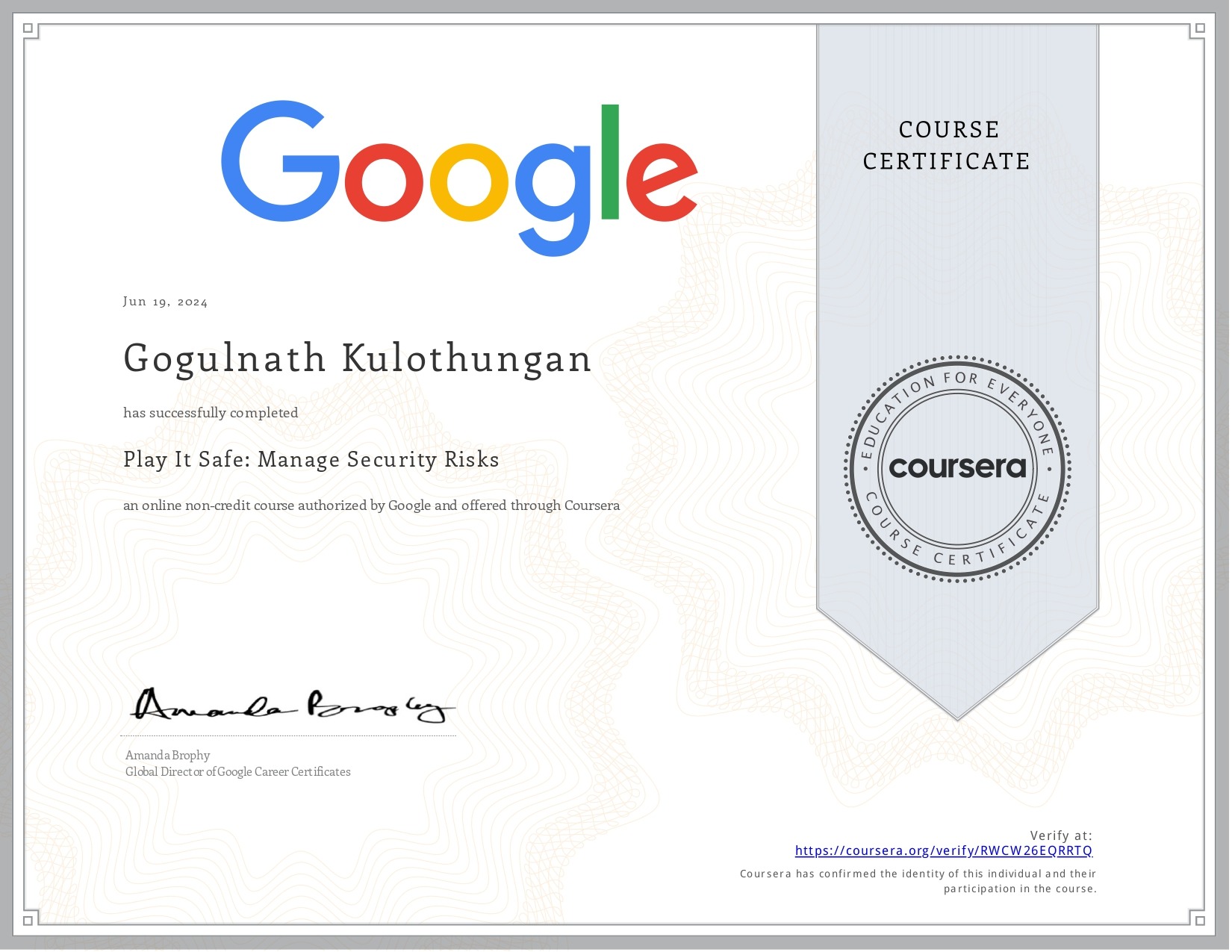Certifications
In addition to my professional experience, I hold several certifications in security-related fields, including "Google" Cybersecurity certificates
These certifications have equipped me with a deep understanding of cybersecurity principles, risk management, and best practices for protecting sensitive information.
My passion for continuous learning and my dedication to staying updated with industry trends drive my professional growth and commitment to excellence. I am eager to leverage my expertise in cloud backup and security to contribute to innovative and secure solutions.

The Google Cybersecurity Foundation course covers the core principles and best practices essential for establishing a strong cybersecurity framework. Key topics include:
· CIA Triad and Security Principles: Emphasizes the importance of Confidentiality, Integrity, and Availability (CIA Triad) as foundational concepts, ensuring data protection through robust authentication, authorization, and adherence to security policies and procedures.
· Encryption and Cryptography: Covers encryption techniques, including symmetric and asymmetric encryption, hashing, and cryptographic key management to secure data in transit and at rest.
· Threat Landscape and Security Frameworks: Provides insight into various threats and attack vectors like malware and phishing, along with strategies to defend against them, and highlights the importance of security frameworks and standards such as NIST and ISO/IEC 27001 for implementing best practices and achieving compliance.

Managing Security Risks:
Risk Assessment and Identification:
Conduct thorough assessments to identify and prioritize potential security threats and vulnerabilities using techniques such as vulnerability assessments and threat modeling.
Risk Mitigation and Control Implementation:
Develop and implement appropriate security controls to mitigate identified risks, including technical measures like firewalls and administrative measures like policies and training programs.
Continuous Monitoring and Integration:
Continuously monitor and review the effectiveness of implemented controls, update risk assessments regularly, and integrate risk management into organizational processes to ensure ongoing protection against evolving threats.

Network security in cybersecurity focuses on safeguarding data integrity, confidentiality, and availability within networked environments. This involves implementing robust access controls, authentication mechanisms, and encryption to protect against unauthorized access and data breaches. Utilizing firewalls, intrusion detection/prevention systems, and secure communication protocols ensures secure network traffic management and data transmission. Continuous monitoring of network activities enables early detection of threats, complemented by proactive incident response strategies for timely mitigation. Effective network security measures are essential for maintaining operational continuity and protecting sensitive information against evolving cyber threats.

Through this course, I learned how to identify and evaluate organizational assets and understand their value to the business. I gained insights into recognizing various threats and vulnerabilities and analyzing how they interconnect. It helped me understand risk management strategies, including assessing potential impacts and implementing effective mitigation measures. I also explored cybersecurity frameworks like NIST and ISO 27001, which provide a structured approach to managing security. Additionally, I learned the importance of incident response planning and recovery processes to minimize the impact of security incidents. The course emphasized best practices, such as implementing preventive measures, continuous monitoring, and staying adaptable to evolving threats.

Through this course, I gained hands-on experience with Linux and SQL, mastering essential Linux commands for navigation, file management, and automation through shell scripting. I also learned system administration basics like process and user management. On the SQL side, I developed skills in writing queries for managing and analyzing data, from basic operations to advanced features like joins and subqueries. The course taught me how to combine Linux and SQL for efficient data processing, enhancing my ability to manage and analyze complex datasets effectively.
Python
I successfully completed a 44-hour comprehensive course in Python Programming and Data Exploration, offered by NIIT Academy, a globally recognized institution for professional skill development.
During the course, I gained in-depth knowledge and hands-on experience in:
• Python Programming Fundamentals: Understanding syntax, data types, loops, and conditionals.
• Data Exploration: Analyzing, processing, and visualizing data using Python libraries like Pandas, NumPy, and Matplotlib.
• Problem-Solving Skills: Writing efficient and optimized Python scripts for real-world scenarios.
• Practical Projects: Working on data-driven projects to derive meaningful insights.
My performance in the course was rated “Good”, reflecting a strong grasp of the concepts and consistent effort. This certification signifies my proficiency in Python and my ability to apply these skills effectively in data analysis and programming roles.
Certificate Details:
• Registration Number: R201192800119

Oracle Cloud Infrastructure Foundation with AI 2025
Issued by Oracle | Credential ID: 101418416OCI25FNDCFA | Valid through April 2027
From my perspective, earning the Oracle Cloud Infrastructure 2025 Certified Foundations Associate certification represents a strong foundational step in my journey toward cloud security and architecture. This certification validated my understanding of core OCI services such as compute, storage, networking, identity and access management (IAM), and cloud governance.
Through this program, I gained insight into OCI’s shared security model, multicloud strategy, and pricing models, which reinforced my ability to design scalable, secure, and cost-effective cloud environments. It also strengthened my grasp of automation, monitoring, and disaster recovery principles within the Oracle ecosystem—skills that complement my broader experience in cloud backup and data protection.
This certification reflects my commitment to continuous learning and adds depth to my expertise across multi-cloud platforms, including AWS and Azure, as I transition further into cloud security engineering and compliance-driven infrastructure roles.

